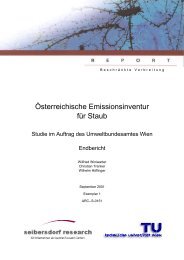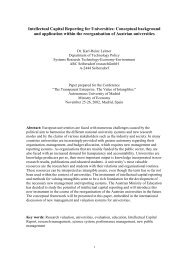ALPMON FINAL REPORT - ARC systems research
ALPMON FINAL REPORT - ARC systems research
ALPMON FINAL REPORT - ARC systems research
Create successful ePaper yourself
Turn your PDF publications into a flip-book with our unique Google optimized e-Paper software.
Contract ENV4-CT96-0359 <strong>ALPMON</strong><br />
forest. Furthermore, streams could not be classified due to their representation in mixed pixels<br />
together with bank vegetation. On the other hand the auxiliary data supported classification itself by<br />
establishing rules for selected classes (e.g. sealed surfaces do not occur on steep slopes).<br />
Partly, additional features derived from the high resolution satellite data sets (see WP8) were<br />
integrated in the classification process. Texture features were used for the delineation of sealed<br />
surfaces in the Dachstein and Cordevole test sites. The forest / non-forest separation in the Dachstein<br />
test site was based on a fused Landsat TM/Spot pan image.<br />
Some main difficulties crystallised in most classifications:<br />
� Forest age in many test sites could not be classified due to the natural appearance of the forest<br />
with a mixture of all tree age categories. Only the Dachstein test site is dominated by managed<br />
forest with a common age class within one stand.<br />
� Forest type in some test sites is mainly mixed, with only a few pure coniferous or broad-leaved<br />
stands.<br />
� Tree species composition is an important information for two applications (national park<br />
management and avalanche risk). However, some tree species could not be separated (spruce,<br />
pine, and stone pine). Dwarf mountain pine could not be separated sufficiently with the satellite<br />
data available for most test sites. This is on one hand due to spectral similarity with other<br />
coniferous trees and, on the other hand, due to mixture with other tree species in one stand.<br />
However, in the Dachstein and the Mangfall test site it was possible to classify dwarf mountain pine<br />
and green alder by means of winter respectively spring images, where the low growing trees are<br />
covered with snow whereas the high growing trees are snow free.<br />
� Wet lands were well recognised in the Mangfall test site by using the thermal infrared band of<br />
Landsat TM (TM6). However, this approach is not applicable e.g. to the Dachstein test site, as wet<br />
land areas here are relatively small and beyond the resolution of TM6 with 120m.<br />
� Sealed surfaces cannot be separated from rock, gravel, and soil based only on the spectral<br />
characteristics of these classes, as the spectral signatures are too similar. Additional information<br />
has to be introduced to classify this category with higher accuracy, or the information must be<br />
taken from GIS data.<br />
On the other hand, most categories required by the customers could be classified with sufficient<br />
accuracy. In general no problems occurred with the classification of the forest type in those areas,<br />
where pure coniferous or broad-leaved stands are common. Forest age could be classified at least in<br />
some test sites, where pure age stands occur. In the Dachstein test site it was possible to separate<br />
pure larch stands from mixed spruce/larch stands and pure spruce stands (possibly mixed with pine<br />
and /or stone pine). In the Dachstein and Mangfall test sites even dwarf mountain pine and green alder<br />
could be classified by means of winter satellite data. Furthermore, some classes could be divided into<br />
subclasses (e.g. pasture and meadow, carbonate and silicate rocks) giving more detailed information.<br />
Problems with the classification of water bodies or sealed surfaces could be overcome by introducing<br />
auxiliary data into the classification process. In general, it can be stated that the outcome of<br />
classification was satisfactory with respect to the local as well as the European wide applications. This<br />
was confirmed by the customers in the first <strong>ALPMON</strong> customer work shop held from February 4-5,<br />
1999 at Innsbruck, as well as in the final project evaluation.<br />
2.2.7 Verification of Classification Results (WP10)<br />
The verification phase was intended to give evidence on the quality of the classification results<br />
(Congalton, 1991). The results of the verification are confusion matrices for each classification giving<br />
true error rate estimates for each class and for the total classification. The accuracy of the<br />
classification results was determined for all classified parameters based on the ground information<br />
collected at each sample plot. The statistical analyses of accuracy included Kappa statistics, confusion<br />
matrices, regression analyses of observed versus estimated values, etc.<br />
All analysis of classification results was based on the use of an error matrix or contingency table. It is a<br />
very effective way to represent accuracy, in that the accuracy of each category is plainly described<br />
along with both the errors of inclusion (commission errors) and errors of exclusion (omission errors)<br />
present in the classification. Error matrix can be used for a series of descriptive and analytical<br />
statistical techniques.<br />
JR, RSDE, ALU, LMU, Seibersdorf, WSL 23




